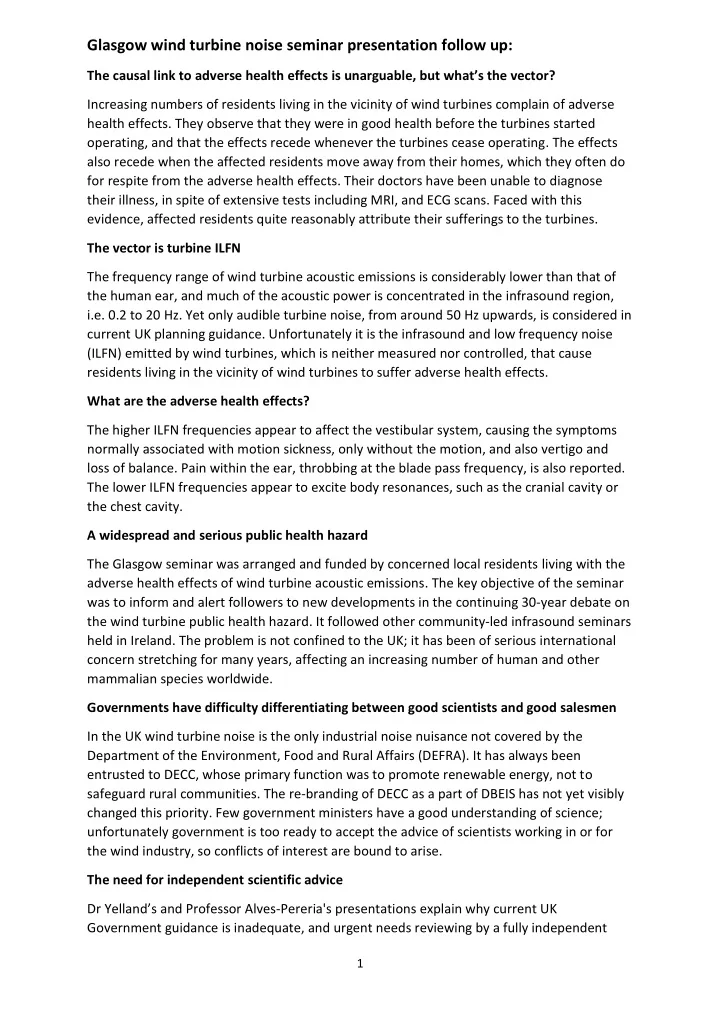

Glasgow wind turbine noise seminar presentation follow up: The causal link to adverse health effects is unarguable, but what’s the vector? Increasing numbers of residents living in the vicinity of wind turbines complain of adverse health effects. They observe that they were in good health before the turbines started operating, and that the effects recede whenever the turbines cease operating. The effects also recede when the affected residents move away from their homes, which they often do for respite from the adverse health effects. Their doctors have been unable to diagnose their illness, in spite of extensive tests including MRI, and ECG scans. Faced with this evidence, affected residents quite reasonably attribute their sufferings to the turbines. The vector is turbine ILFN The frequency range of wind turbine acoustic emissions is considerably lower than that of the human ear, and much of the acoustic power is concentrated in the infrasound region, i.e. 0.2 to 20 Hz. Yet only audible turbine noise, from around 50 Hz upwards, is considered in current UK planning guidance. Unfortunately it is the infrasound and low frequency noise (ILFN) emitted by wind turbines, which is neither measured nor controlled, that cause residents living in the vicinity of wind turbines to suffer adverse health effects. What are the adverse health effects? The higher ILFN frequencies appear to affect the vestibular system, causing the symptoms normally associated with motion sickness, only without the motion, and also vertigo and loss of balance. Pain within the ear, throbbing at the blade pass frequency, is also reported. The lower ILFN frequencies appear to excite body resonances, such as the cranial cavity or the chest cavity. A widespread and serious public health hazard The Glasgow seminar was arranged and funded by concerned local residents living with the adverse health effects of wind turbine acoustic emissions. The key objective of the seminar was to inform and alert followers to new developments in the continuing 30-year debate on the wind turbine public health hazard. It followed other community-led infrasound seminars held in Ireland. The problem is not confined to the UK; it has been of serious international concern stretching for many years, affecting an increasing number of human and other mammalian species worldwide. Governments have difficulty differentiating between good scientists and good salesmen In the UK wind turbine noise is the only industrial noise nuisance not covered by the Department of the Environment, Food and Rural Affairs (DEFRA). It has always been entrusted to DECC, whose primary function was to promote renewable energy, not to safeguard rural communities. The re-branding of DECC as a part of DBEIS has not yet visibly changed this priority. Few government ministers have a good understanding of science; unfortunately government is too ready to accept the advice of scientists working in or for the wind industry, so conflicts of interest are bound to arise. The need for independent scientific advice Dr Yelland ’s and Professor Alves-Pereria's presentations explain why current UK Government guidance is inadequate, and urgent needs reviewing by a fully independent 1
panel of experts which should include the Independent Noise Working Group, along with other objective and accredited acousticians. Wind industry acoustician Leventhall’s statement "I can state quite categorically that there is no significant infrasound from current designs of wind turbines" is repeated in the environmental assessments of numerous wind farm planning applications, but it is simply untrue. It does however imply a concern that, if it did exist, wind turbine ILFN would be problematic. The truth is that wind turbines do emit ILFN, and it is problematic to an extent that it is a dangerous public health hazard. There is quantitative evidence of wind turbine ILFN emissions, not least from the industry’s own published measure ments. Melvin Grosvenor in introducing the seminar, outlined his experience over the past decade acting as a lay advocate for many local communities faced with inappropriate wind farm applications, both at the planning stage and after construction, when causing adverse health effects. Dr John Yelland MA DPhil (Oxon) MInstP FIET MIOA AMASA is a well-qualified physicist with experience in acoustics spanning over 50 years, and a frequency range spanning 0.1 Hz to 10 GHz. He has worked on the generation and propagation of electromagnetic waves as well as acoustic waves. His Oxford DPhil thesis was on the thermal and acoustic properties of liquid helium three. Patrick Dugast, Acoustics and Vibration Engineer, reported the position of residents living in the vicinity of wind turbines in France; the legislation there is somewhat different from the UK legislation, but the regulatory problems in general, and the consequent adverse health effects in particular, are very similar to those in the UK. Professor Mariana Alves-Pereira of the Lusofona University in Portugal has degrees in physics and biomedical engineering, and a PhD in environmental science. Her team has been researching vibroacoustic disease since 1980, initially focused on the low frequency noise that adversely affected the health of aeronautical technicians. In her presentation she explains how she discovered the effects that industrial low frequency noise from a variety of sources has on people and animals. Professor Alves-Pereira presented a case study from Portugal where a family was found to be exposed to ILFN caused by the operation of nearby wind turbines (2006-2013). On-off testing showed the increase in ILFN inside the home was indeed associated with turbine operation. In May 2013 a Supreme Court of Justice Decision based on this evidence, ruled that all of the 4 offending Wind Turbines must be permanently removed with an award to the family for increased damages. Video A video of the presentations will be available shortly at http://www.windsofjustice.org.uk/2017/10/presentations-at-the-wind-turbine-noise- infrasound-seminar-glasgow-22-september-2017/ END Published 17th October 2017. 2
Reference: Glasgow Wind Turbine Noise Seminar 22-09-2017 MRG - JVY of INWG. 3
Recommend
More recommend